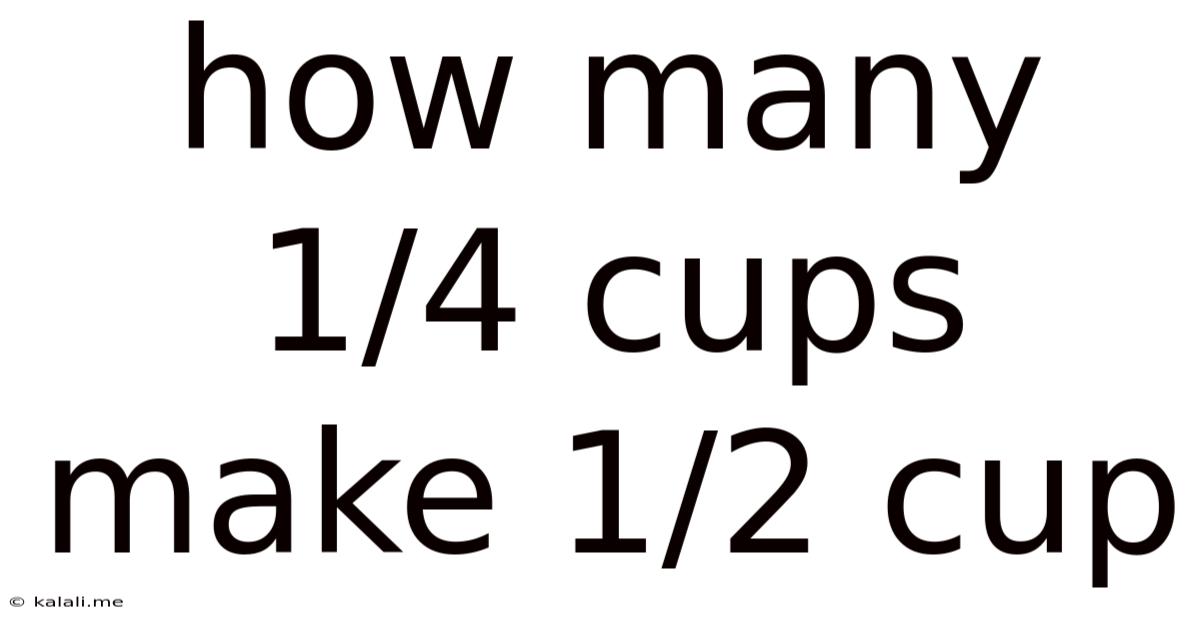How Many 1 4 Cups Make 1 2 Cup
Kalali
Jun 29, 2025 · 5 min read

Table of Contents
How Many 1/4 Cups Make 1/2 Cup? A Deep Dive into Fraction Conversions and Culinary Applications
This seemingly simple question, "How many 1/4 cups make 1/2 cup?", opens the door to a broader understanding of fraction manipulation, a crucial skill in various fields, from baking and cooking to construction and engineering. This article will not only answer the question directly but will also explore the underlying mathematical principles, offer practical applications in culinary arts, and delve into the importance of precise measurements in different contexts. We will also touch upon related fractional conversions and explore how to approach similar problems efficiently.
Understanding Fractions: A Refresher
Before diving into the specific calculation, let's revisit the fundamentals of fractions. A fraction represents a part of a whole. It's composed of two numbers: the numerator (the top number) and the denominator (the bottom number). The numerator indicates how many parts you have, and the denominator indicates how many parts make up the whole.
In our question, we're dealing with fractions of a cup: 1/4 cup and 1/2 cup. 1/4 cup means one part out of four equal parts of a whole cup, while 1/2 cup represents one part out of two equal parts of a whole cup.
Calculating 1/4 Cups to 1/2 Cup
The simplest way to determine how many 1/4 cups make 1/2 cup is through direct division or multiplication. We can think of this problem in two ways:
-
Method 1: Division: How many times does 1/4 go into 1/2? This translates to the mathematical expression: (1/2) / (1/4). To divide fractions, we invert the second fraction and multiply: (1/2) * (4/1) = 4/2 = 2. Therefore, two 1/4 cups make 1/2 cup.
-
Method 2: Multiplication: We know that 1/4 cup is half of 1/2 cup (since 1/4 * 2 = 2/4 = 1/2). Therefore, we need two 1/4 cups to equal one 1/2 cup.
Practical Applications in Cooking and Baking
Precise measurements are paramount in culinary arts, particularly baking. A slight variation in ingredient quantities can significantly alter the final product's texture, taste, and consistency. Understanding fraction conversions helps ensure accuracy in recipes.
For instance, if a recipe calls for 1/2 cup of sugar, and you only have a 1/4 cup measuring cup, you know precisely how many scoops to use to get the required amount. This is crucial for achieving the desired outcome. Many recipes, particularly those from older cookbooks or passed down through generations, might use fractions extensively. Knowing how to convert these fractions ensures you can follow the recipe accurately.
Beyond 1/4 and 1/2 Cups: Expanding Fraction Conversions
The principles of fraction conversion extend beyond this specific example. Let's explore some related scenarios:
-
How many 1/8 cups make 1/4 cup? Similar to the previous calculation, we can use division: (1/4) / (1/8) = (1/4) * (8/1) = 8/4 = 2. Therefore, two 1/8 cups equal 1/4 cup.
-
How many 1/3 cups make 1 cup? Here, we divide 1 (which can be represented as 1/1) by 1/3: (1/1) / (1/3) = (1/1) * (3/1) = 3. Therefore, three 1/3 cups make one cup.
-
How many 1/2 cups make 1 1/2 cups? We can represent 1 1/2 as 3/2. Then we divide 3/2 by 1/2: (3/2) / (1/2) = (3/2) * (2/1) = 6/2 = 3. Three 1/2 cups make 1 1/2 cups.
Importance of Accurate Measurement in Other Fields
The need for precise measurements extends beyond cooking and baking. Consider these examples:
-
Construction and Engineering: In construction, accurate measurements are critical for structural integrity. Errors in measurements, even small fractions of an inch, can lead to significant problems.
-
Pharmaceuticals: In the pharmaceutical industry, precise measurements are vital for medication dosage. Inaccurate measurements can have life-threatening consequences.
-
Science and Research: Scientific experiments often require incredibly precise measurements. The accuracy of these measurements directly impacts the validity and reliability of research findings.
Tips for Working with Fractions:
-
Find a Common Denominator: When adding or subtracting fractions, it's crucial to have a common denominator. This means converting the fractions so they share the same bottom number.
-
Simplify Fractions: Always simplify fractions to their lowest terms. For instance, 2/4 should be simplified to 1/2.
-
Use Visual Aids: If you're struggling with fraction conversions, consider using visual aids like diagrams or pie charts to represent the fractions.
-
Practice Regularly: The more you practice working with fractions, the more comfortable and proficient you'll become.
Conclusion: Mastering Fractions for a More Precise World
The seemingly simple question of how many 1/4 cups make 1/2 cup serves as a gateway to understanding the broader world of fraction manipulation. Mastering fraction conversions is essential not only for culinary success but also for accuracy and precision in numerous other fields. By understanding the underlying principles and practicing regularly, you can confidently navigate the world of fractions and ensure accurate measurements in any context. Remember that consistent practice and a clear grasp of the fundamentals will pave the way for success in tackling even more complex fractional calculations. The ability to accurately convert and manipulate fractions is a valuable skill that will serve you well throughout life.
Latest Posts
Latest Posts
-
Why Did The Scientists Stay At The Math Teachers House
Jul 31, 2025
-
How Many Laps Is 500 Yards In A Pool
Jul 31, 2025
-
What Is A 17 Out Of 23
Jul 31, 2025
-
3 Liter Of Water How Many Glasses
Jul 31, 2025
-
5 Letter Words With 2nd Letter I
Jul 31, 2025
Related Post
Thank you for visiting our website which covers about How Many 1 4 Cups Make 1 2 Cup . We hope the information provided has been useful to you. Feel free to contact us if you have any questions or need further assistance. See you next time and don't miss to bookmark.